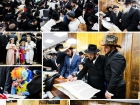Scheduled Cloud Transport To The Beis Ha’mikdash
An elderly couple were taking a leisurely drive on the Belt Parkway. On the way, the husband turned on the news and they heard that traffic was backed up for miles on the Belt and they recommend that people avoid it • Read More
BEGIN WITH A GRIN
An elderly couple were taking a leisurely drive on the Belt Parkway. On the way, the husband turned on the news and they heard that traffic was backed up for miles on the Belt and they recommend that people avoid it.
“Did you ever hear such fake news in your life? We’re driving on the Belt and it’s empty!”
The wife decided to check out on her phone the images from the traffic helicopters, where she saw a clear shot of their car followed by a massive line of cars…
WEEKLY/MONTHLY TRIP SCHEDULE
This week’s parsha, Reeh, introduces us, for the first time, to the holy city of Yerushalayim. Actually, the name “Yerushalayim” does not appear anywhere in the Five Books of the Torah. It is referred to as “the place that G-d will choose,” and everyone knows that this means where the Shechina will reside, on Mount Moriya in Yerushalayim.
This Shabbos is Rosh Chodesh Elul which is known as the “month of personal accounting,” the month which concludes the months of the year. The way it comes out this year with Rosh Chodesh Elul on Shabbos parshas Reeh, the Chabad custom is that the haftora we read (is not “Aniya So’ara” as in other years but) is “Hashomayim Kis’i,” the final prophecy in the book of Yeshaya. The haftora ends with (66:23), “And it shall be from month to month and from Shabbos to Shabbos, all flesh will come to bow before Me, says the Lord.”
Although this haftora is not connected to the parsha but to the date (Shabbos-Rosh Chodesh), since everything in the world is by divine providence, and all the more so as regards the Jewish calendar which is constructed according to Torah rules, it is appropriate to find a connection between them.
While this sometimes requires some creative insight, in the case of the haftora “HaShomayim Kis’i” and parshas Reeh the alignment between the two is actually astonishing. First of all, it is the first (and only) parsha that speaks about “the place that G-d will choose,” that holy place that we will (as described in the haftora) ascend to “every [new] month and every Shabbos” in the Geula. If that wasn’t enough, a large part of the parsha deals with the obligation of every Jew to be oleh regel, “to ascend and see and bow,” just as the concluding verse of the haftora describes.
However, those with a sharp eye will note the obvious and interesting difference between the parsha and the haftora. In the parsha it talks about aliya l’regel “three times a year,” on the three holidays. In the future, says the prophet, aliya l’regel will take place every Rosh Chodesh and every Shabbos. What is the reason for this difference? Why were three times a year sufficient in the time of the Beis HaMikdash while in the time of the Geula we will go up much more frequently? Isn’t that a bit much to spend every Shabbos in Yerushalayim?
The Rebbe Rashab quotes a Medrash with which he explains the reason for the frequent pilgrimage and gathering. The purpose of aliya l’regel is the G-dly revelation that every Jew saw and experienced in the Beis HaMikdash. This G-dly revelation was dependent on the time being a time of joy because “joy breaks all barriers” and is the determining factor for the revelation. An analogy would be someone marrying off his only child who goes wild with joy and disperses money to tzedaka and kisses everyone, etc. The unlimited joy that he feels leads to an unrestrained revelation of his soul, an absolute expansiveness that he cannot contain.
Similarly, in special times of unfettered joy, G-d reveals Himself to all in an unlimited way. This revelation in meant to impact on, strengthen and elevate, the deep bond between G-d and a Jew. This is the reason that the mitzva of aliya l’regel when the Beis HaMikdash stood was only on three holidays, time defined as “appointed times of joy.” Now, however, we don’t have true joy, not for us and not for G-d Himself either. In the time of exile, wherever there is joy it’s always diluted with sadness. Therefore, the verse says, “G-d will rejoice with His deeds,” “Yisrael will rejoice with their Maker. “Will rejoice,” in the future, because now, unfortunately, there is no true absolute joy.
In the future, in the Geula, when our own joy with G-d will be revealed in its completeness, we will have the need, power and ability to go up to the Beis HaMikdash more frequently, every Shabbos and every Rosh Chodesh, and we will also be treated to revelations of divine joy to take back with after every such trip.
FLYING (TO THE MIKDASH) ON CLOUD NINE
That’s all good and well but how are we going to get to Yerushalayim every Shabbos? Just thinking of the traffic jams will make you lose interest. The Medrash comes to our aid. In the Pesikta it says that this mass aliya to Yerushalayim will happen with clouds, much faster than a plane (and much less expensive).
The final thing we need to work out is departure times, when the first cloud leaves, how much time it takes, and where we would sleep at night.
In connection with this, the Medrash (ibid) brings some opinions:
1-The clouds will bring the Jewish people to Yerushalayim erev Shabbos, Yom Tov and Rosh Chodesh. They will spend all Shabbos in the Beis HaMikdash and on motzoei Shabbos the clouds will return them to their homes.
2-The flight to Yerushalayim will be on Shabbos with a trip for shacharis in the Beis HaMikdash and as soon as it’s over, the Jews will return home.
3-On Rosh Chodesh that falls out on Shabbos, like this week, they will make the trip twice! They will make the trip for shacharis and will then return home. They will then return for mincha in the Beis HaMikdash.
The reason for the disagreement about this has to do with the legal debate regarding the “techum Shabbos” whether it applies “above ten tefachim.” The Tannaim argue about whether the prohibition to leave the techum applies only to a person walking on the ground or also to someone traveling through the air (like on a plane or cloud).
The opinions of the Tannaim in the Medrash are contingent on this argument: According to the first view, it is forbidden to go past the techum even when one is above ten tefachim. Consequently, it will be forbidden to travel on a cloud on Shabbos for a distance beyond 2000 cubits. So we must say that the trip will take place on erev Shabbos and they will remain there for the entire Shabbos.
According to the second (and third) view, there is no prohibition regarding techumim when above ten tefachim. Consequently, one could travel via cloud and traverse even great distances. Thus, they ruled that the trip will take place on Shabbos itself. The reason that the third view maintains that the Jews will fly twice on Shabbos Rosh Chodesh is based on the repetition in the verse (Yeshaya 60:8), “Who are these that fly like a cloud and like doves to their cotes?” The imagery of both clouds and doves indicated to the Tanna that the Jewish people will go to the Beis HaMikdash twice. And who knows, maybe we will start to fly like doves (too).
Now, for the practical lesson. It doesn’t say that the entire Jewish people will see the Beis HaMikdash but “all flesh.” From this, the Medrash learns that one who makes himself as flesh in this world, will merit to see the Shechina in the World to Come. Flesh is soft. When we say that a person makes himself as flesh it means that he has nullified (softened) his desires, has accomplished ‘veer from evil and do good,’ and by doing so he merits to come and see G-d.
The Medrash continues (based on the juxtaposition of the verses) that whoever closes his eyes “from seeing evil” will merit to see “the King in his glory” in the future. So, if we desire to see G-d every Shabbos, we should not be looking where our eyes don’t belong.
Until we merit to ascend every Shabbos and holiday, we need to remember that nowadays, our Yerushalayim is Lubavitch, and the Beis HaMikdash is 770, and we need “to ascend and see and bow,” especially now at the beginning of the month of Elul, the month of preparing for the trip to the Rebbe MH”M for Tishrei. Furthermore, the upcoming year is a Shnas Hakhel, a year that the Rebbe wants to see every one of us.
TO CONCLUDE WITH A STORY
Rabbi Chaim Binyamini (shliach of the Rebbe to Brazil) went to the Kinus Ha’Shluchim in 5748 (which was also a Hakhel year). The Rebbe gave out the famous maamar, “V’Shavti B’Shalom 5738,” the Rebbe’s longest maamar.
After receiving the kuntrus and moving on, the Rebbe called him back and gave him another kuntrus and said, “This is for the 15 years that we did not see one another.”
R’ Binyamini did not understand this. After all, he had gone to the Rebbe every two or three years and fifteen years hadn’t passed since he last saw the Rebbe! When he returned to Brazil he decided to write to the Rebbe about this. He received a response (Likkutei Sichos vol. 39, Hosafos to parshas Vayelech) in which the Rebbe said that he meant R’ Binyamini had missed a Shnas Hakhel twice in a row (in 5741 and 5734) and that was considered like 14-15 years! That’s how important it is that we go to the Rebbe in a Shnas Hakhel.
Good Shabbos!
87
Join ChabadInfo's News Roundup and alerts for the HOTTEST Chabad news and updates!











































